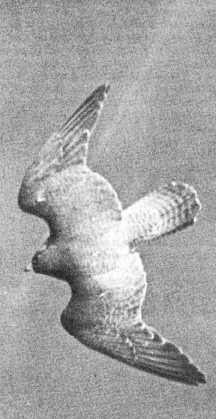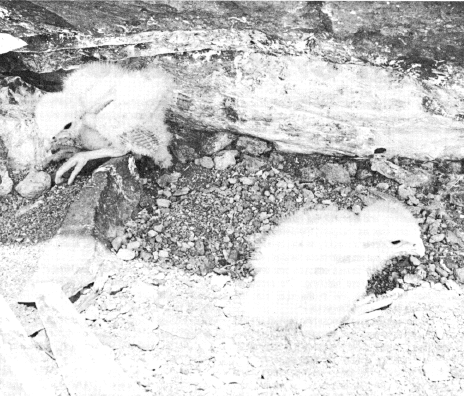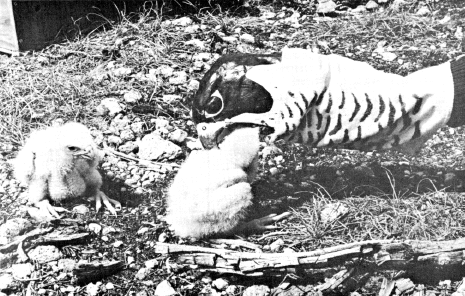Peregrine Rescue Efforts Continue at Crater Lake
Park Science, Vol. 2, No. 4
Winter 1991, pp. 9
BY Mark Forbes
National Park Service
Dept. of Interior
The peregrine falcon is on the brink of non-existence in Oregon. In the 1930s there were 39 known active peregrine nests; today there is only one, at Crater Lake National Park. The pair of birds that use this site have had only marginal reproductive success the last few years.
 |
| Adult peregrine makes angry circles in the sky as workers visit the nest. |
Peregrine falcons have been observed within the park since the late 1800s. Reports of single birds were received, but no pairs were seen until July 1979, when a USGS research party working inside the caldera observed three peregrines and reported the information to Park officials. The U.S. Fish and Wildlife Service (USFWS) was informed and a research biologist from that agency was sent to the Park. After a day of searching the nest ale was located. It was determined that the site was active, the peregrine had successfully fledged two young, and that one addled egg remained in the nest. The birds were observed for the remaining summer months and after their fall departure, a National Park Service team descended into the nest to retrieve the addled egg and any prey remains.
The recovered material was sent to the USFWS for analysis. This analysis closely paralleled data gathered from other addled peregrine eggs: Egg shell thinning was 19 percent and DDE shell levels were 19 parts per million (ppm).
The steady decline in peregrine populations has been tied directly to the use of the pesticide DDT. Residues of DDT and subsequent by-products DDE, DDD and others were rapidly spread throughout the world after the chemical came info widespread use in the mid 1940s. This contamination is associated with eggshell thinning and reproductive failure among a number of bird species, including the peregrine.
Eggs with thin shells are easily broken or damaged during incubation but an even more serious problem is dehydration, which causes embryos and developing chicks to die before hatching. The peregrine population dropped so low in the U.S. that the species was listed as endangered.
In 1980 it was decided to observe the nest ate but take no direct management action to assist in the reproductive success of the birds. The pair returned to the site in the spring and laid three eggs, none of which were viable. The eggs were recovered in early September and sent for analysis. The results were the same as in 1979: 18-19 percent shell thinning with an 18 ppm DDE level.
The Crater Lake NP staff met with the USFWS. Oregon Department of Fish and Wildlife (ODFW) and the Predatory Bird Research Group (PBRG) during the fall and winter of 1980-81. A management plan was written following the guidelines established in a draft Pacific Coast Peregrine Falcon Recovery Plan. The p&s plan was submitted to the USFWS for The consultation process required almost two months with approval given two days before the management action was planned.
This plan called for a site “manipulation” involving personnel from several agencies and organizations. Climbers from PBRG would rappel into the site. remove any eggs and in turn replace captive-bred young. The technique had been developed and refined by Cornell University and the Peregrine Foundation at Fort Collins, CO. The PBRG located at the University of Santa Cruz had performed similar manipulation in California and was willing to assist on the Crater Lake project.
A nest site observer had been hired in early April to watch the birds. record their activities and establish when the female laid the clutch of eggs. The individual hired was ideally suited for the assignment He had worked with the FWS rehabilitating injured peregrines, he could cross-country ski to the site. and he enjoyed the solitude and isolation of the assignment.
The peregrines returned and began their courtship in early April. By the end of the month, three eggs had been laid. The manipulation was scheduled for 10 days following the egg-laying date. This time period was critical to ensure acceptance of transplanted birds yet minimize potential for egg dehydration.
Several days were needed to organize logistics 01 air and land travel, with each mode of transportation located in the best possible position. Considering the potential for error, the manipulation process went smoothly.
The young captive-bred chicks were flown to the site by helicopter and hand carried to the staging area. A climber from the PBRG rappelled into the nest with the young, removed the three eggs and was back on top within 23 minutes. The adult female had begun brooding the chicks before the climber had reached the top. The two young were successfully raised by the adults and fledged 3-1/2 weeks after the manipulation.
The eggs were taken lo the PBRG facilities where they were specially treated with wax to prevent dehydration. Two were hatched in mechanical incubators but the third was found to be dead. The two young, both females, were retained at the facility to be used in the captive breeding program. One was later mated with a male bird from Yosemite NP which had been injured in a fall from its nest.
The eggshell analysis results were similar to the previous years and indicated that the eggs would have failed had they been left in the nest. By all standards the manipulation was successful in fledging two young in the wild, and the artificial hatching of two wild eggs which otherwise would have failed.
The manipulation process was repeated this year. Again three eggs were removed and replaced with two healthy young. The two young have successfully fledged, however, all three wild eggs were found to be addled. Preliminary date indicate the eggs died within the first week of being laid and before the transfer was effected.
Costs for this project were shared by the NPS and ODFW. The NPS funds were all from the park’s operating budget. The State’s portion was a special non-game wildlife fund contributed by Oregonians through tax donations. The program at Crater Lake will continue for at least three more years. The ODFW will expand its involvement in re-establishing peregrines in the state. Two sites have been located which are ideal habitat. Captive breed young will be introduced into the wild through a “hacking” process, possibly to reoccupy historic nest sites in future years.
Such measures might seam futile, were it not for the hope that the long lived pesticide, DDT, will decline and the levels that reach raptors like the peregrine will subsequently diminish. Meanwhile, efforts will continue to insure the reproductive success of the peregrine until environmental conditions improve.
Forbes is a Resource Management Specialist at Crater Lake NP. All photos are courtesy of the Oregon State Dept. of Fish & Wildlife.
 |
| Rocky ledge serves as a peregrine nest. Here the two introduced chicks huddle and await discovery and acceptance. |
Other pages in this section


